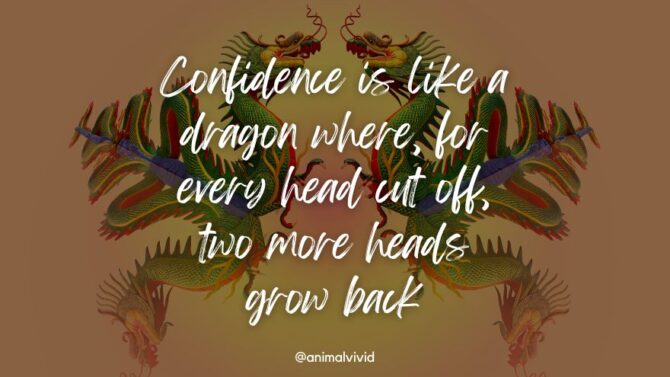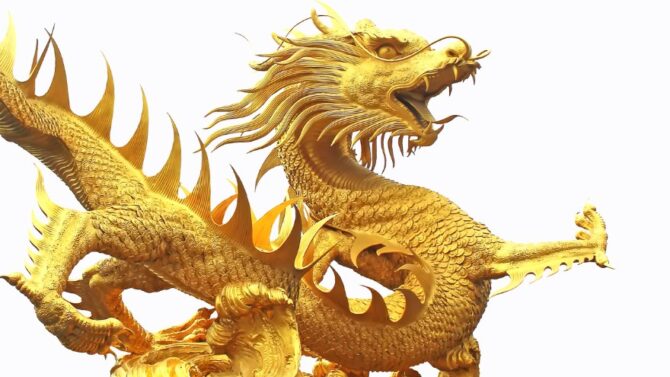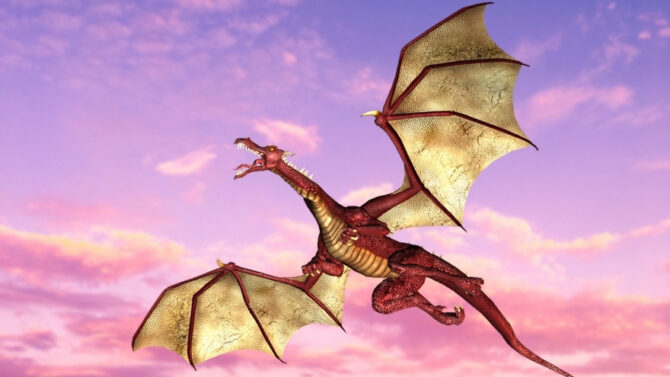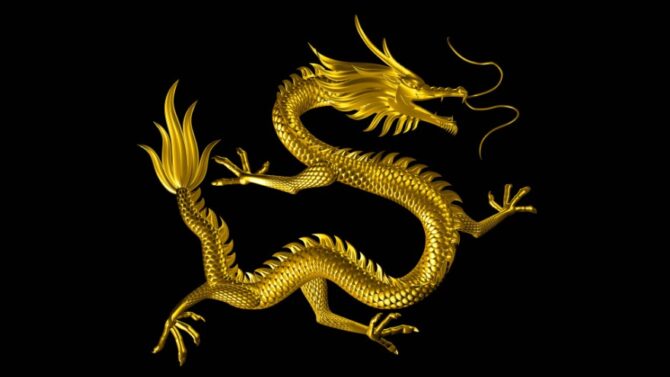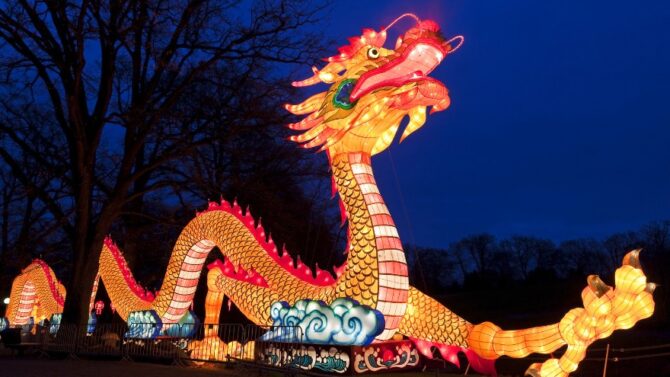Huge, scaly, and scary dinosaurs and dragons are often seen as relatives. It isn’t uncommon for people to mix the two up, leading to some confusion.
What are we to say about dinosaurs and dragons? Are they the same? Different? How can we compare the two?
Though they are both huge creatures, dinosaurs and dragons are very different.
For starters, dragons are mythical, but dinosaurs existed with fossils as evidence. That said, there are also similarities, and they may even be related.
Interested to discover the difference between dinosaurs and dragons? Let’s find out more!
Dinosaurs vs Dragons – The Differences
1. Dragons are fictional; dinosaurs aren’t
For centuries, dragons were believed to be real. However, that belief has since died down.1
It might be that the first dinosaur fossils discovered fostered the idea that dragons existed—we’ll view this in detail in a later section.
Dragons are very popular in legends and myths, with their reputation being influenced by many perspectives, including religion.
Overall, dragons were depicted as a bigger form of domestic dogs, useful in some cases and dangerous in others. There is no evidence that dragons ever existed, however.
It’s a different story for dinosaurs. There is fossil evidence for the existence of these creatures, the first of which was a megalosaurus described in 1824.2
Since then, more fossils have been discovered, enough to establish that dinosaurs aren’t figments of our imaginations.
2. Dragons breathe fire; dinosaurs don’t
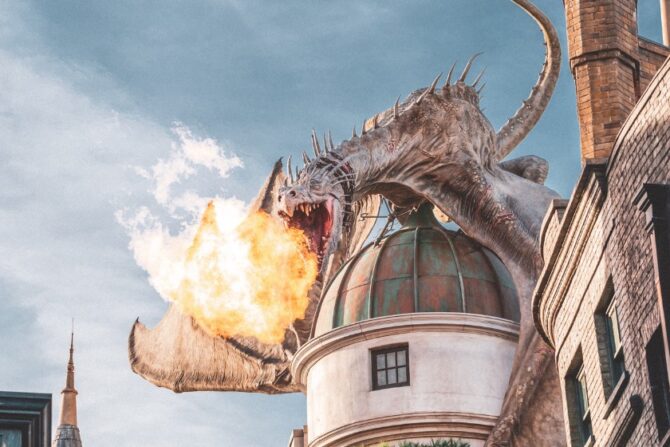
While there are varying descriptions of dragons, the predominant view is of them as fire-breathing creatures, even in modern pop culture.
In movies like Game of Thrones and How to Train a Dragon, the dragons are all fire-breathing. This, in part, is what makes them popular to date.
By contrast, dinosaurs are not fire-breathing, and there is zero evidence that proves the contrary.
Besides their size, there’s nothing mysterious or mystical about dinosaurs based on the fossils.
Even more, no animal has been known to make or breathe out fire. The ability to start a fire is reserved for humans.
3. All dragons can fly, but not all dinosaurs can
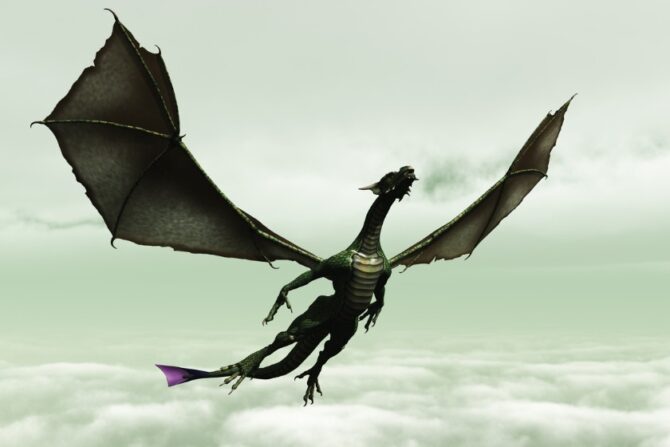
Dragons often appear with wings, and it would be rare to see a dragon without one. These wings enable them to soar in the air like birds, regardless of size.
It’s not uncommon in movies and stories to see dragons as large as airplanes covering the land with a shadow as they float by.
Again, dinosaurs are less impressive by comparison. Many species were land creatures and didn’t come with wings.
There are a few examples of dinosaurs that could fly—like the Archaeopteryx—but not as common as our fire-breathing friends. The flying dinosaurs do not fly as gracefully as dragons too.
4. Dragons are mythical; dinosaurs are extinct
The reason we have no dinosaurs in our world today (not counting birds, and their relatives) is that they became extinct millions of years ago.3
This occurred at the end of the crustaceous period. The cause of extinction is linked to the famous asteroid, but there might have been other factors like volcano eruptions and climate changes.
The reason we have no dragons in our world today (thankfully, that would have been a disaster) is that they are fictional creatures passed down from one generation to another as a legend. Powerful, but not real.
5. Dragons lived close to humans; the same can’t be said for dinosaurs
According to legend, dragons were often seen around humans. Remember the slight parallel with domestic dogs?
They are portrayed either as pets or vicious monsters, but in both cases, they do not live too far away from humans.
There are some exceptions, of course, but the general rule is of a relationship, good or bad, with humans.
However, dinosaurs went extinct 66 million years ago, at a time placed before early humans began to appear.
This means the chances of them having any contact with humans are low to nonexistent. The only “dinosaurs” we live close by today are birds, the relatives.
We also know other animals that lived during that period, like crocodiles, alligators, turtles, and lizards. Sadly, all we have of old dinosaurs are fossils.
6. Dinosaurs are classified as reptiles. Dragons, well…
Because they share many similar traits with reptiles like crocodiles, lizards, and alligators, the dinosaur is also classified as a reptile.
This is why birds are now considered reptiles as well. Reptiles are divided into five subtypes: Lizards, crocodiles, turtles, snakes, and dinosaurs.4
Dragons don’t have any biological classification as it is fictional. If it was real, it might have been classified either as a reptile or even an amphibian.
But these are all speculations. The description of dragons makes it even harder to speculate what biological group it might be in.
They have features of reptiles, amphibians, and even mammals combined. Some even have heads like eagles!
7. Dragons are full carnivores; dinosaurs have a varied diet
Dragons are like lions in their dietary need. They’re portrayed as apex predators, preying on livestock and humans when they aren’t domesticated.
Though humans in these stories could take dragons down with combined effort, it was clear who had the upper hand in a raid. The fire breath alone is enough to conquer humans.
Dinosaurs come from different species, and each of these has its dietary needs. They can be carnivores, herbivores, or omnivores.
Despite what we see in scary dinosaur movies, dinosaurs weren’t in contact with humans long enough to eat one.
8. Dragons had magic. Dinosaurs are ordinary creatures
Adding to their long list of extraordinary qualities, many dragons possess magical qualities.
The advantage of being a fictional creature is the freedom to be above natural, and in many tales, dragons are like that.
Some could speak with humans, read minds, cast spells, and even control elements.
Dinosaurs are ordinary in comparison. Like any other real animal, the only ‘magic’ they have is the set of natural adaptations that helped them survive till the asteroid struck.
9. Dinosaurs have a wider habitat than dragons

When they roamed the earth, dinosaurs lived in different habitats. They could be found in plains, tundra, jungles, wetlands, deserts, and forests.
The fossils have been found in these habitats, bearing witness to their widespread living conditions. This is probably due to the number of species.
Dragons lived mainly in caves and mountains, either guarding treasure or minding their business. Some may live around water bodies, but their habitats are limited.
10. Dragons had a higher IQ
Dragons are usually smart, but the extent varies. Some are just as smart as humans and, even more, dispensing advice when needed.
Others don’t have such a high IQ, but they can easily orders. Their range of smartness goes from that of a pooch dog breed to a scholar.
However, dinosaurs don’t seem to be so intelligent, and it is unlikely they would have made good pets.
Perhaps herbivorous species could have been domesticated like cattle, but their carnivorous counterparts will not have been domesticated so easily.
Dinosaurs vs Dragons – The Similarities
The long list of differences may make dinosaurs and dragons seem like oranges and apples.
However, there aren’t only divergent points. The creatures have some similarities, which we’ll look into next:
1. They both lay eggs
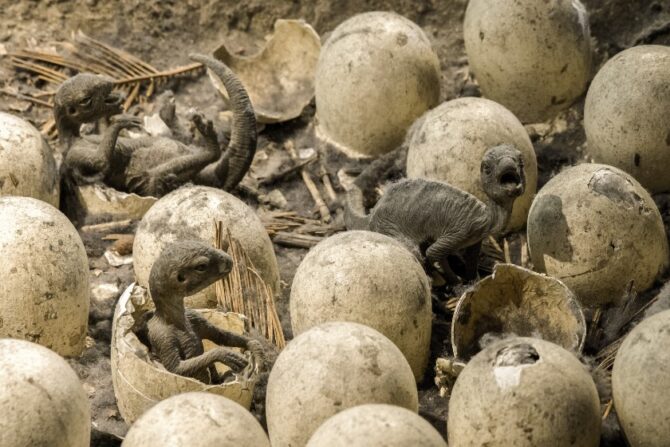
Dinosaurs and dragons are both oviparous. There hasn’t yet been any one of these creatures that gave birth live.
While there have been debates over whether dinosaurs had the maternal instincts of mother hens or simply left their babies to fend for themselves, there is little doubt they laid eggs.
Dragon mothers were often portrayed as being fiercely protective of their little ones to the point of wreaking havoc if someone tries to touch even one of their eggs.
They are known to be territorial, a trait that shows in their childcare.
2. Their tails are extended
Another similarity between dragons and dinosaurs is their tail. Dinosaurs come with a variety of tails, but in general, they are all extended and long.
These tails may have had different uses, like balance while running or defense against an enemy.
Dragons generally had long tails which looked like armor with spikes. The main purpose for the tail was defense, but it might have also helped in balance when flying.
3. They have scales
One possible reason dinosaurs and dragons are mixed up is the scaly skin they both have.
The majority of dinosaur species have scales, though a few have feathers (like the velociraptor and the Microraptor).
The scales on some dinosaurs are thick enough to act as armor, protecting them against predators.
Unsurprisingly, dragons also protect themselves with their hard, scaly skin. In many dragon stories where the creature is the villain, it is always hard to penetrate the skin.
Not all dragons have scaly skin, though. Some individuals come with hair.
4. They are big
Dinosaurs and dragons come in a variety of sizes, but generally, they are known to be huge.
The typical dinosaurs and dragons are sometimes as tall as buildings. During their prime, dinosaurs were the largest animals on earth, surpassing crocodiles and alligators.
Dragons may not be the biggest fictional creature, but they can easily compete for the position.
The size is what makes them vicious and hard to contend with. Slaying a dragon is a sign of bravery in many medieval fantasy movies, and the size is one reason why.
5. They are not alive
Dinosaurs and dragons have different reasons for not being in one world today, but this is the last point they have in common.
There is no place you can find a real-life dragon or dinosaur (the prehistoric form) in modern times.
Dinosaurs don’t exist because they’ve been extinct for millions of years. Dragons don’t exist because they’re fictional creatures.
Related Questions
Do dinosaurs look like dragons?
Many dinosaur species do not resemble dragons and are distinct from each other. However, there are some exceptions. The popular Tyrannosaurus Rex has a head shaped like a typical dragon.
Another dinosaur that looks like a dragon is the juvenile version of the pachycephalosaurus known as the Dracorex Hogwartsia, named after Harry Potter.
Were dinosaur fossils mistaken for dragons?
Given that some people believed dragons were real, they may have had some “evidence” from dinosaur fossils mistaken for dragons.
They already had the idea of dragons from stories, so it must have been easy to connect the dots.
Dinosaurs vs dragons, who will win in a fight?
Both dinosaurs and dragons are vicious, so in a hypothetical fight, it’ll depend on the species. A T-Rex can hold his own against any dragon, but a herbivorous dinosaur may not do so well.
Dragons are built for battle, so a clash of this nature would be a strong one.
Wrap Up
The next time someone accidentally confuses both creatures and may want to wave it off with “they’re the same,” you know now that there are more differences than similarities.
While it may be true that dinosaurs made dragons more popular, they aren’t the same.
References & Notes
- Radford B., McKelvie C. 2022. Dragons: A brief history of the mythical, fire-breathing beasts. Live Science.
- Megalosaurus. Museum of Natural History.
- When did dinosaurs become extinct? USGS.
- Are birds reptiles? UCSB ScienceLine.


